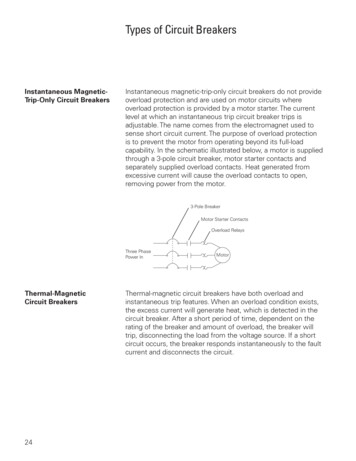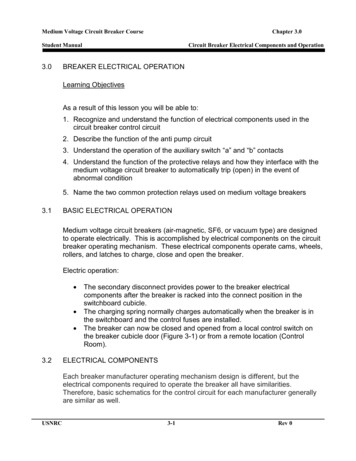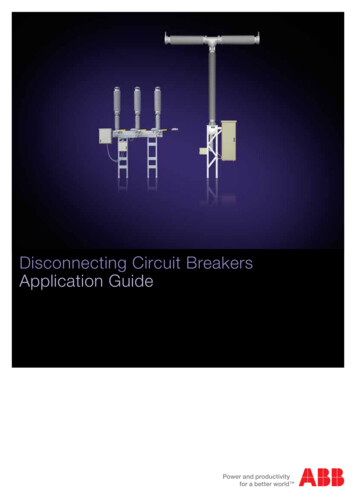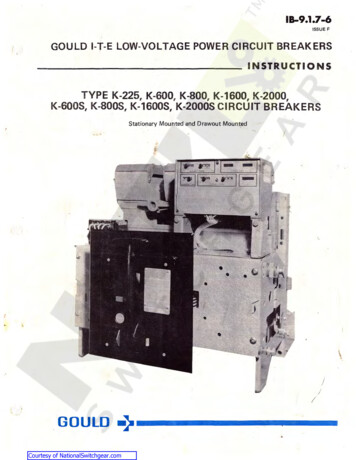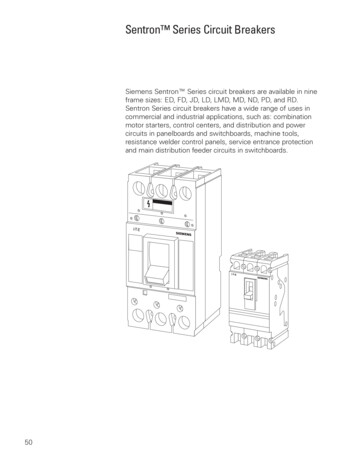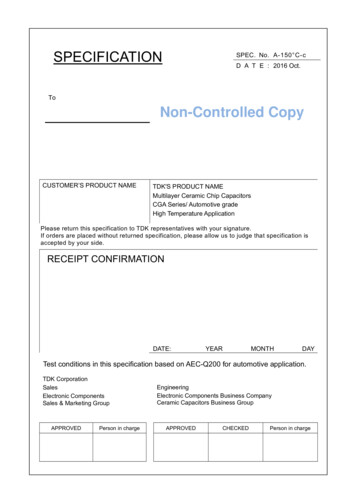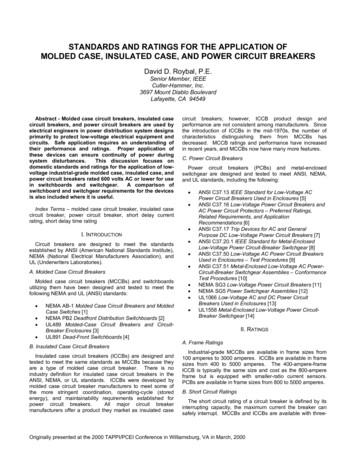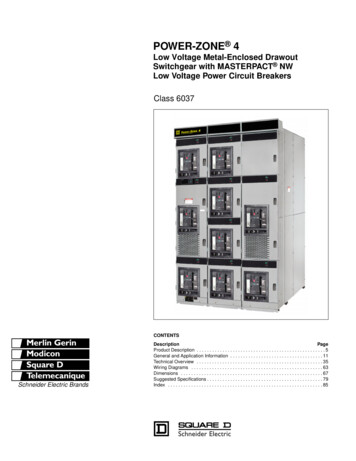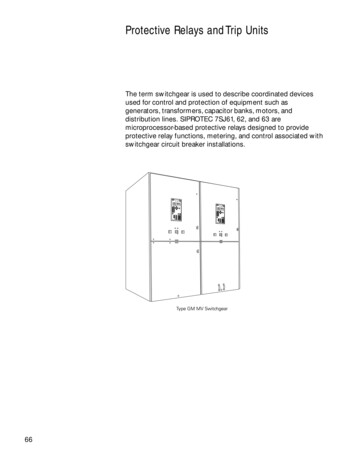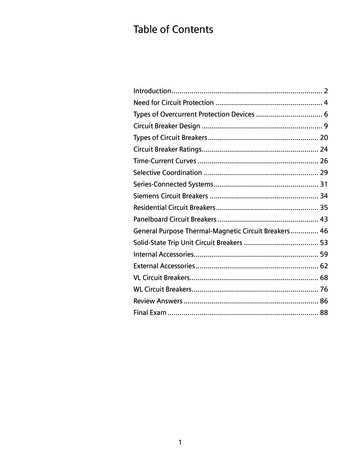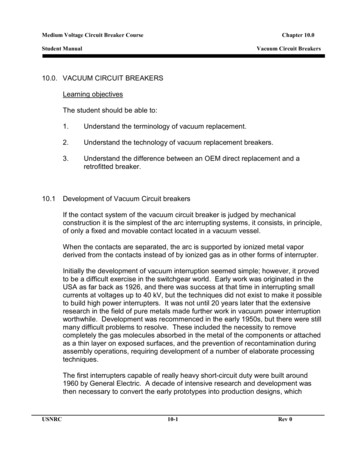
Transcription
Medium Voltage Circuit Breaker CourseChapter 10.0Student ManualVacuum Circuit Breakers10.0. VACUUM CIRCUIT BREAKERSLearning objectivesThe student should be able to:10.11.Understand the terminology of vacuum replacement.2.Understand the technology of vacuum replacement breakers.3.Understand the difference between an OEM direct replacement and aretrofitted breaker.Development of Vacuum Circuit breakersIf the contact system of the vacuum circuit breaker is judged by mechanicalconstruction it is the simplest of the arc interrupting systems, it consists, in principle,of only a fixed and movable contact located in a vacuum vessel.When the contacts are separated, the arc is supported by ionized metal vaporderived from the contacts instead of by ionized gas as in other forms of interrupter.Initially the development of vacuum interruption seemed simple; however, it provedto be a difficult exercise in the switchgear world. Early work was originated in theUSA as far back as 1926, and there was success at that time in interrupting smallcurrents at voltages up to 40 kV, but the techniques did not exist to make it possibleto build high power interrupters. It was not until 20 years later that the extensiveresearch in the field of pure metals made further work in vacuum power interruptionworthwhile. Development was recommenced in the early 1950s, but there were stillmany difficult problems to resolve. These included the necessity to removecompletely the gas molecules absorbed in the metal of the components or attachedas a thin layer on exposed surfaces, and the prevention of recontamination duringassembly operations, requiring development of a number of elaborate processingtechniques.The first interrupters capable of really heavy short-circuit duty were built around1960 by General Electric. A decade of intensive research and development wasthen necessary to convert the early prototypes into production designs, whichUSNRC10-1Rev 0
Medium Voltage Circuit Breaker CourseChapter 10.0Student ManualVacuum Circuit BreakersRequired sustained confidence in the objectives. Both vacuum contractors andpower circuit breakers then went into quantity production.Vacuum interruption now offers the nearest approach so far achieved to the idealcircuit-breaker performance, in terms such as freedom from maintenance of thecontact system for life, and consistency of interruption. However the maximumservice voltage per interrupter is still restricted to the order of 36 kV, andalthough higher interruption voltage circuit breakers have been demonstrated astechnically feasible, the economic problems associated with such assemblieshave not yet been adequately solved in relation to the competition, moreespecially from SF6 gas breakers.Development of 11-15 kV distribution switchgear has taken place in two phases.In the ‘first generation’ switchgear, vacuum interrupters merely replacedconventional interrupters, the general form and arrangement of the switchgearbeing otherwise unchanged.10.2Roll In replacements: OEM breakers manufactured to replace older ACB’s10.2.1 GE’s was the first manufacturer to offer direct “Roll in Replacement”breakers. This is the concept of an original manufacturer providing areplacement vacuum breaker for their older ACB’s. These first generationvacuum circuit breakers were not economic, but they had the advantagesthat they could quickly modify existing air breakers to use vacuuminterrupters, and thus service experience with vacuum interrupters wasquickly gained without the delay and expense of designing complete newequipment. Figure 1 shows the Vacuum replacement breaker for aMagne-Blast. The original operating mechanism was used with theaddition of a hydraulic dash pot for dampening the (Absorbing) the closingforces of the heavy Magne-Blast breaker. This was necessary becausethe contacts were only traveling less than an inch compared to thedistance of almost 6” with ACB.10.2.2 The new vacuum breakers have smaller operating mechanisms becausethey no longer need to move the contacts as far. Some first generationOEM replacement breakers used their 480 volt mechanisms to operatesuch as the ABB. Figure 2 shows the ABB Vacuum breaker with a K-Linetype mechanism and Figure 3 is the K-Line 480 V Mechanism.10.2.3 Westinghouse designed a direct replacement vacuum breaker for theDHP. This breaker is a direct roll in replacement. No modification isrequired for the switchboard. (See Figure 4 & 5)USNRC10-2Rev 0
Medium Voltage Circuit Breaker CourseChapter 10.0Student Manual10.3Vacuum Circuit BreakersRetro-fill and Retrofit BreakersIs interchangeable term for converting an ACB to vacuum breaker, also referred toas “roll in vacuum replacements”. To vacuum retrofit is the process to change an ACB to vacuum breaker, theoperating mechanism and contact structure is replaced but the interface withthe cubicle is the same. Retrofill is what is being done to the cubicle the existing cubicle is being usedto accommodate a new vacuum style breaker this could be a directreplacement retrofitted breaker or a new manufactured breaker.The replacement vacuum breaker will be a complete unit and is racked directly intoexisting cubicle and connects to the existing primary bus and secondary controls. Itcould be manufactured using the existing truck and interface components or couldbe built from ground up with all new material. All the interface, racking andinterlocks would be integrated into the new vacuum element. Figure 4 is a Siemensvacuum element on an ABB HK truck.One of the problem areas with the vacuum retrofits is the MOC interface. The newbreaker operating mechanism is smaller and sometimes can’t actuate the cubicleMOC.10.4Vacuum Circuit Breaker Operation and MaintenanceAs with air circuit breakers, the reliability of vacuum circuit breakers is contingentupon its unfailing performance, preventive maintenance and testing is required tomaintain safe operation.10.4.1 Contact Wear:Vacuum interrupter contacts wear principally because of the erosion causedby arcing but normally only to a negligible degree by no-load operation. Inmost interrupters the erosion rate is not a constant but increases withincreasing current. The best commercial interrupters will interrupt their fullshort-circuit current some hundreds of times, and will give many thousands ofoperations on normal full load current.1. When provided, the contact wears and gap indicators should bemeasured and compared with manufacturer’s specifications. Mostbreaker manufacturers provide go/nogo tools or the breakers havepermanent marks or gages which are used to indicate wear.USNRC10-3Rev 0
Medium Voltage Circuit Breaker CourseChapter 10.0Student ManualVacuum Circuit Breakers10.4.2 Vacuum bottle integrity tests:AC or DC Hipot testing should be performed across the open contacts instrict accordance with manufacturer’s recommended test voltage. The testequipment should have a full wave rectification.10.4.3 Other testing:All other testing such as insulation testing, micro-ohm tests and timing shouldbe performed to circuit breakers and compared to acceptance criteria. Anymechanical adjustments should also be verified and compared to themanufacturesUSNRC10-4Rev 0
Medium Voltage Circuit Breaker CourseChapter 10.0Student ManualVacuum Circuit BreakersFigure 10-1 GE Magne-Blast replacementUSNRC10-5Rev 0
Medium Voltage Circuit Breaker CourseChapter 10.0Student ManualVacuum Circuit BreakersFigure 10-2 ABB HK Vacuum replacementFigure 10-3 ABB 480 Volt breaker mechanismsUSNRC10-6Rev 0
Medium Voltage Circuit Breaker CourseChapter 10.0Student ManualVacuum Circuit BreakersFigure 10-4 Siemens element used to retrofit an ABB HK BreakerUSNRC10-7Rev 0
Medium Voltage Circuit Breaker CourseChapter 10.0Student ManualVacuum Circuit BreakersFigure 10-5 DHP Vacuum replacementUSNRC10-8Rev 0
Medium Voltage Circuit Breaker CourseChapter 10.0Student ManualVacuum Circuit BreakersFigure 10-6 DHP Roll in vacuum replacementUSNRC10-9Rev 0
vacuum element on an ABB HK truck. One of the problem areas with the vacuum retrofits is the MOC interface. The new breaker operating mechanism is smaller and sometimes can't actuate the cubicle MOC. 10.4 Vacuum Circuit Breaker Operation and Maintenance As with air circuit breakers, the reliability of vacuum circuit breakers is contingent
